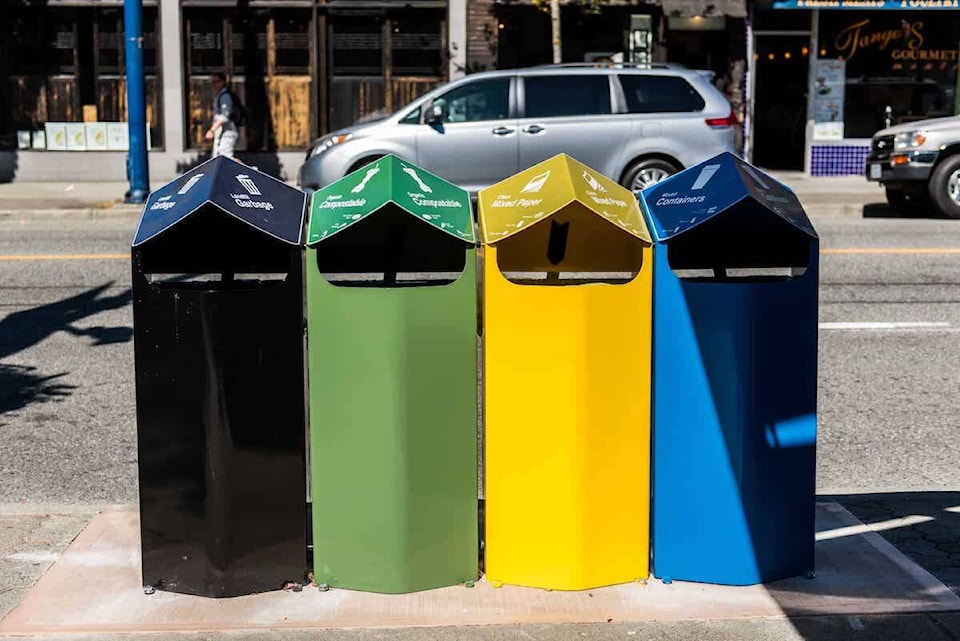Tim Collins
The ubiquitous blue boxes that, since 1989, have lined West Shore streets for recycling pick up are a great indicator of the community’s commitment to a sustainable future.
Yet, even with the 35th anniversary of the program, many of us are still getting things wrong.
But, first the good news.
The West Shore communities have about a 90 per cent household participation rate for the recycling program and the contamination rates for material are very low. The contamination rate measures the percentage of material that can’t be recycled since it is contaminated by things like food waste.
“It’s because we have a three-stream program that divides material into either paper fibres, glass, or plastics,” said Tom Watkins, the manager of solid waste and recycling operations for the Captial Regional District (CRD).
“In places like Calgary or Surrey, they operate on a single stream program where everything is sort of dumped in together and their contamination rates are upwards of 20 per cent. You can’t effectively mix everything and then try to sort it afterward. That’s like trying to unbake a cake.”
But even with the program’s success, there are still some pervading and mistaken beliefs about the program.
For example, many folks still believe that the recycling program costs the taxpayers a bunch of money.
This is not the case.
In 2014, an amended regulation to BC’s Environmental Management Act shifted the entire cost of recycling from the taxpayers to the product producers. The extended producer responsibility applies to high-volume producers—manufacturers, distributors, and retailers that annually bring in at least a million dollars and put 1,000 kg of packaging into the BC marketplace.
Those producers banded together to form Recycle BC. It’s a not-for-profit organization that serves to collect materials through contracts with both private waste management companies and local governments. In Langford, the CRD is contracted to collect the waste and it, in turn, manages that collection through a sub-contract with a private firm.
In January, that contract will be with GFL Environmental. It will take over from the Emterra Group, having won out in a regular bid for the service.
Another mistaken belief is that a good portion of material from the blue boxes ends up in the landfill.
“That’s simply not true,” said Watkins. “The drivers will simply not take some materials and will leave that material in your box for proper disposal. They won’t take metal, for example, which can be dropped off at a recycling depot, free of charge.”
They also won’t take plastic pop bottles which can be returned for deposit. So, if you’re annoyed by the “truck-binners” who cruise neighbourhoods and root through boxes looking for bottles, they aren’t really hurting the program. The mess they leave behind may, of course, be a different issue.
“We will send some contaminated material to the landfill, but the percentage is very low. The important thing is that we’ve diverted more than 527,000 tonnes of material from the landfill since 1989,” Watkins said.
Another gripe about the program centers on the environmental impact of having all those big trucks crisscrossing our neighbourhoods.
GFL, along with other companies in the business, is bringing an increasing number of all-electric trucks into its fleet.
“It’s an ideal situation for electric vehicles,” said Watkins. “The start and stop nature of the job is great since it’s the braking that charges the truck’s batteries. And, it should also be noted that those vehicles that aren’t yet electric are all-natural gas, with a reduced carbon footprint.”
Despite the success of the program, Watkins acknowledged that they are constantly working to help educate the public about their recycling habits.
“It doesn’t work, for example, to place a bunch of recyclable material together into a sealed plastic bag,” Watkins said. The machines at the recycling facility can’t sort that material and the staff can’t open them for safety reasons.”
More information on the do’s and don’ts of recycling can be found at the Recycle BC’s website recyclebc.ca/where-to-recycle/recycle-bc-faqs/ .
READ MORE: View Royal approves free transit for 12 to 13-year-olds



